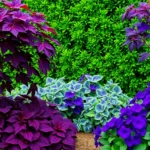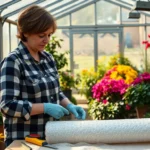L-shaped gardens present unique opportunities that many homeowners don’t fully realize. While these angular spaces might seem challenging at first peek we’ve discovered they’re actually design goldmines waiting to be transformed into stunning outdoor sanctuaries.
The distinct corner configuration of L-shaped gardens creates natural zones that we can leverage for multiple purposes. Whether you’re working with a compact urban plot or a sprawling suburban space these gardens offer incredible potential for creative landscaping answers that maximize both functionality and visual appeal.
We’ll explore innovative design strategies that turn your L-shaped garden’s perceived limitations into its greatest strengths. From creating intimate seating nooks to establishing dramatic focal points you’ll discover how to make every square foot work harder while achieving that magazine-worthy outdoor space you’ve been dreaming about.
Create Distinct Garden Zones in Your L-Shaped Layout
Zone creation transforms your L-shaped garden into multiple functional spaces that serve different purposes throughout the day. We’ll explore three key areas that maximize your unique layout’s potential.
Designate a Formal Dining Area
Position your dining zone in the wider section of your L-shaped garden to accommodate a proper dining table and chairs. We recommend placing this area on level ground with access to your kitchen for easy meal service. Natural shade from existing trees or planned pergolas creates comfortable dining conditions during warmer months.
Consider installing outdoor lighting fixtures like string lights or lanterns to extend evening entertaining hours. Paved surfaces such as flagstone, brick, or concrete provide stable flooring for dining furniture and easy maintenance. Border plantings of herbs like rosemary, thyme, and basil add fragrance while keeping insects away from your dining guests.
Wind protection becomes essential for comfortable outdoor dining experiences. Strategic placement of trellises, privacy screens, or tall plantings shields your dining area from prevailing winds. We suggest incorporating weather-resistant furniture that can withstand seasonal changes while maintaining an elegant appearance.
Establish a Quiet Reading Nook
Create your reading retreat in the narrower section of your L-shaped garden where natural privacy occurs. This intimate space requires minimal square footage but maximum comfort through thoughtful design choices. Position seating to face away from high traffic areas while capturing pleasant garden views.
Comfortable outdoor furniture like weather-resistant cushioned chairs or a small bench provides the foundation for your reading zone. We recommend adding a side table for books, beverages, and reading accessories. Soft landscaping with flowering shrubs, ornamental grasses, and perennials creates a peaceful backdrop.
Shade becomes crucial for comfortable reading sessions during bright daylight hours. Install a small pergola, umbrella, or plant fast-growing climbing vines on an arbor structure. Consider the sun’s path throughout the day when positioning your reading nook to ensure adequate shade during your preferred reading times.
Set Up a Children’s Play Zone
Transform the most visible section of your L-shaped garden into a safe play area where children can explore and play under supervision. Open sight lines from your home’s main living areas allow easy monitoring while maintaining the garden’s aesthetic appeal. Level ground prevents injuries and provides stable surfaces for play equipment.
Soft landscaping materials create safe play surfaces around swing sets, playhouses, or sandbox areas. We suggest using rubber mulch, artificial turf, or well-maintained natural grass to cushion falls and provide comfortable play surfaces. Avoid thorny plants, toxic species, or delicate flowers in the immediate play zone.
Storage answers keep toys and play equipment organized while maintaining your garden’s visual appeal. Weatherproof storage benches, decorative bins, or dedicated storage sheds contain play items when not in use. Incorporate child-friendly plants like sunflowers, cherry tomatoes, or fast-growing flowers to engage young gardeners in planting activities.
Maximize Corner Space with Strategic Plantings
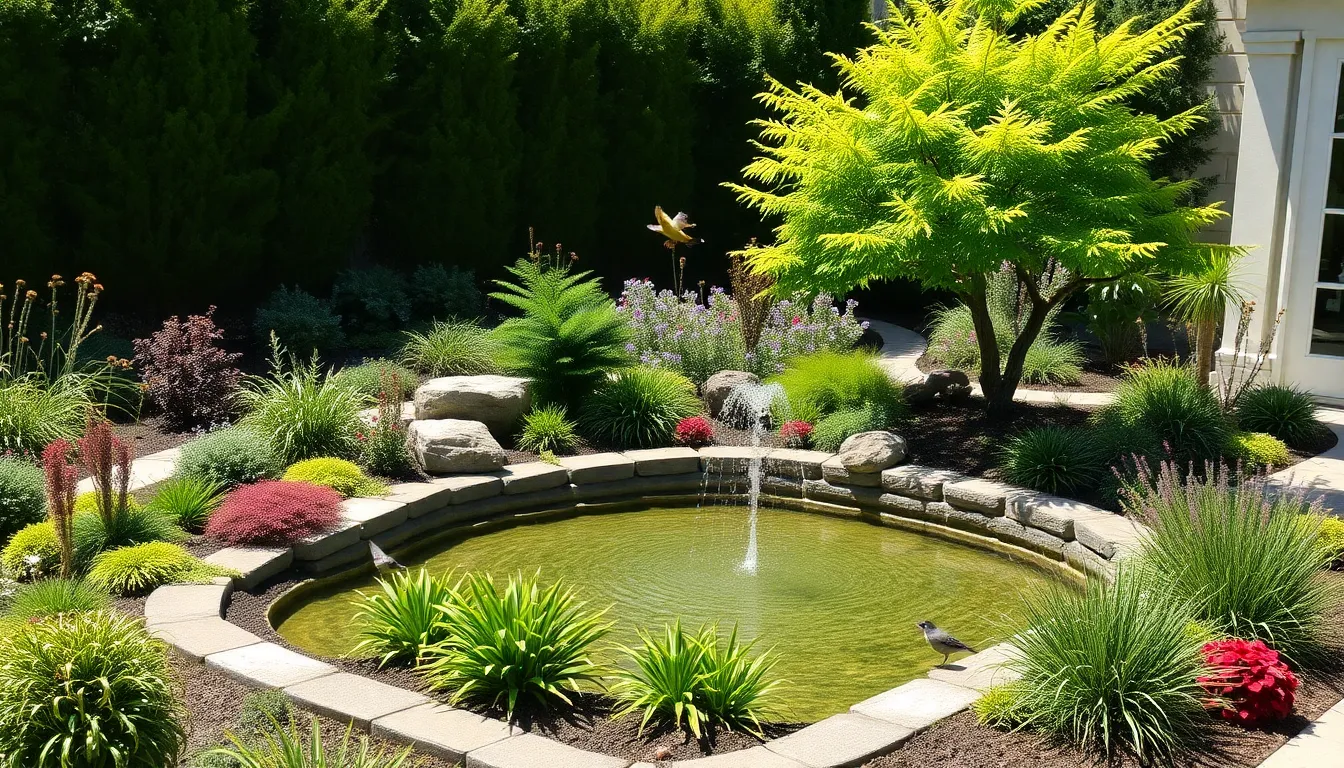
Corner spaces in L-shaped gardens often become neglected areas, but we can transform them into stunning focal points that enhance the entire industry.
Install a Corner Water Feature
Water features work exceptionally well in corner spaces where they can serve as natural gathering points for both people and wildlife. Installing a small fountain or pond in the corner junction creates visual interest while making use of space that might otherwise remain empty. Fountains provide soothing sounds that mask neighborhood noise and help define the transition between different garden zones.
Wildlife benefits significantly from corner water features, as birds and beneficial insects will visit regularly for drinking and bathing. We recommend selecting features that complement your garden’s scale rather than overwhelming the space with oversized installations.
Build a Curved Border Garden
Curved borders soften the angular nature of L-shaped gardens while creating natural flow between different sections. Mixing plants with varying heights and textures along these borders adds depth and visual appeal that draws the eye through the entire space. Taller shrubs planted at the back transition gracefully to medium-height perennials and finally to low-growing ground covers at the front.
Strategic plant placement along curved borders helps create distinct microclimates within your garden layout. Plants that prefer partial shade can nestle behind taller specimens, while sun-loving varieties thrive in the more exposed areas of the curve.
Place a Statement Tree as a Focal Point
Statement trees positioned at the end of each arm of your L-shaped garden create natural endpoints that encourage exploration and movement through the space. These focal points draw attention while providing structure and vertical interest that balances the horizontal lines of your garden design. Ornamental trees like Japanese maples or flowering dogwoods work particularly well as they offer seasonal interest without overwhelming smaller gardens.
Positioning statement trees strategically helps frame views from different vantage points within your home and garden. Each tree becomes an anchor point that organizes the surrounding plantings and creates cohesive design throughout your L-shaped layout.
Design Pathways to Connect Both Arms of Your L-Shaped Garden
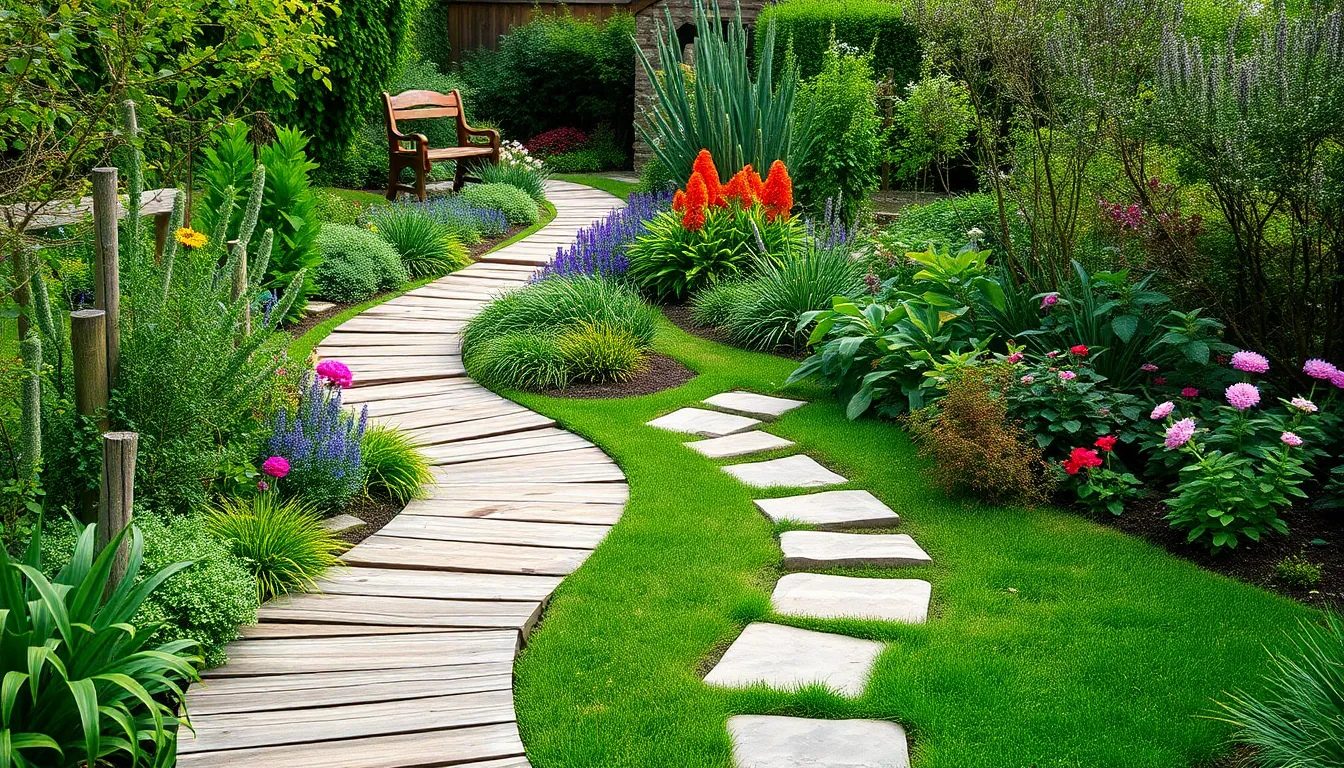
Creating seamless connections between the two sections of your L-shaped garden transforms a potentially disjointed space into a cohesive outdoor sanctuary. Strategic pathway design ensures smooth flow between different zones while adding visual appeal to your garden layout.
Create a Winding Stone Path
Meandering stone pathways offer the most visually appealing solution for connecting both arms of your L-shaped garden. Natural stone materials like flagstone, slate, or fieldstone create an organic feel that complements surrounding plantings beautifully. Curved designs help soften the sharp angles inherent in L-shaped layouts while encouraging leisurely strolls through your garden.
Installing stones with irregular spacing adds movement and prevents the pathway from appearing rigid or formal. Consider varying stone sizes from 12 to 24 inches in diameter to create natural rhythm as visitors walk between garden sections. Joints between stones can be filled with moss, small groundcover plants, or decorative gravel to enhance the pathway’s integration with your industry design.
Install Stepping Stones Through Grass
Stepping stones through grassy areas provide an accessible and budget-friendly pathway option that blends seamlessly into your existing industry. Individual stones placed 18 to 24 inches apart accommodate comfortable walking stride while allowing grass to grow between each element. This approach works particularly well when connecting distant corners of your L-shaped garden without disrupting the natural lawn appearance.
Choose flat, stable stones at least 16 inches wide to ensure safe footing for all family members and guests. Concrete pavers, natural fieldstone, or even large flat river rocks serve as excellent stepping stone materials. Installing each stone slightly below ground level prevents tripping hazards while maintaining easy lawn mower access around the pathway edges.
Build a Wooden Boardwalk
Wooden boardwalks offer a rustic and inviting approach to linking different areas of your L-shaped garden, especially in narrow or wet sections where traditional pathways might prove impractical. Elevated construction keeps feet dry during rainy seasons while providing excellent drainage underneath the walkway structure. Cedar, redwood, or pressure-treated lumber ensures longevity in outdoor conditions.
Building boardwalks 3 to 4 feet wide accommodates comfortable two-person walking while allowing space for handrails if elevation changes require additional safety measures. Incorporate slight curves or angles in boardwalk design to echo your garden’s natural contours and create visual interest. Adding built-in benches or observation platforms along longer stretches transforms your pathway into destination points for relaxation and garden appreciation.
Build Vertical Elements to Add Height and Interest
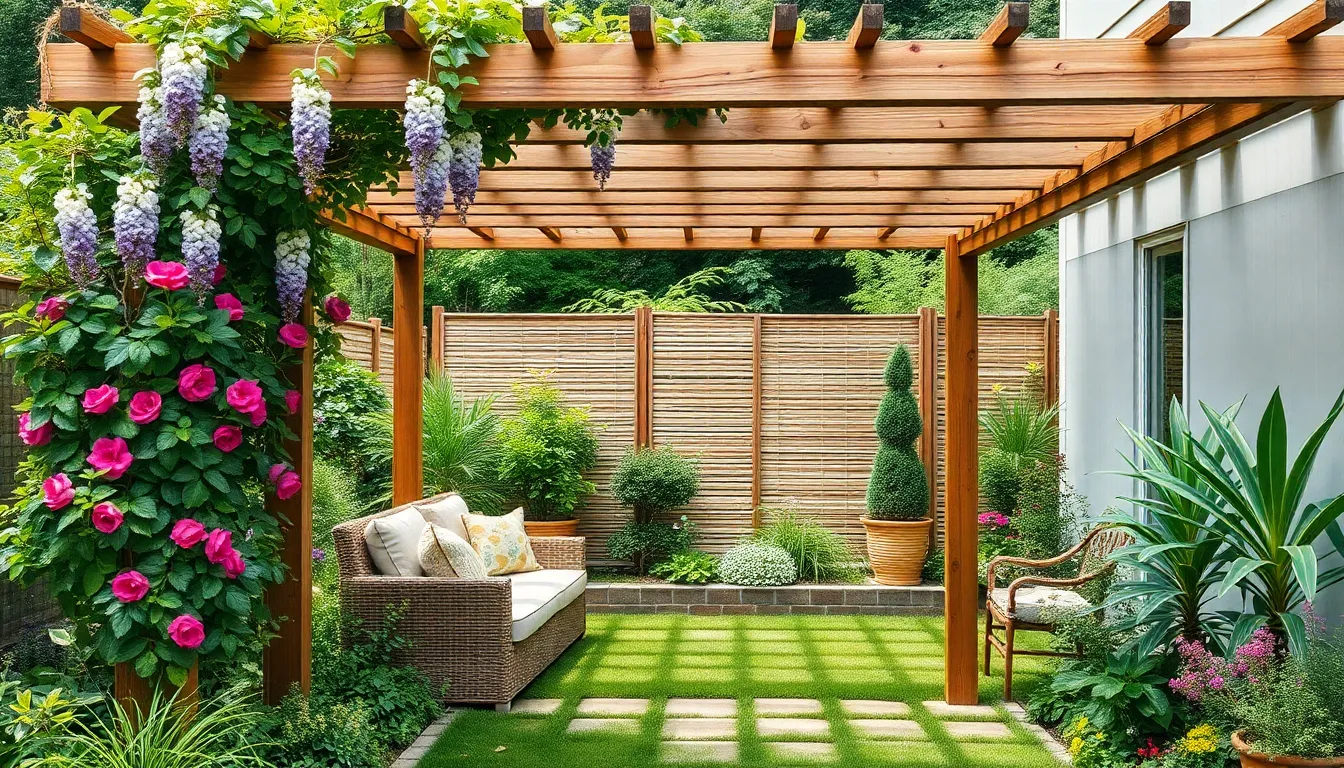
Transforming your L shaped garden requires thinking beyond ground level plantings. We can dramatically enhance both the visual appeal and functionality of our outdoor space by incorporating vertical elements that draw the eye upward.
Construct Pergolas Over Seating Areas
Pergolas serve as architectural anchors that define exact zones within our L shaped garden layout. We recommend positioning these structures over dining areas or lounging spaces to create intimate outdoor rooms that feel separate from the main garden flow. Installing a pergola in the corner junction of your L shaped design provides natural shade while establishing a clear focal point that connects both arms of the garden.
Building these overhead structures allows us to incorporate climbing vines like wisteria or grape vines that’ll provide seasonal interest and additional privacy. We can customize pergola materials to match our home’s exterior, using cedar for a natural look or powder coated aluminum for low maintenance durability. Positioning lighting fixtures within the pergola framework extends our garden’s usability into evening hours.
Install Trellises for Climbing Plants
Trellises maximize our vertical growing space while adding architectural interest to fence lines and bare walls. We can strategically place these structures along the longer arm of our L shaped garden to create living privacy screens that change with the seasons. Installing trellises against existing fences doubles our planting area without sacrificing precious ground space.
Selecting the right climbing plants transforms these vertical supports into stunning garden features. We recommend combining evergreen climbers like ivy with flowering varieties such as clematis or climbing roses for year round appeal. Positioning trellises at different heights creates visual layers that make our L shaped garden appear larger and more ever-changing.
Add Privacy Screens Between Zones
Privacy screens help us define distinct areas within our L shaped garden while maintaining visual flow between spaces. We can install these barriers to separate active play areas from quiet relaxation zones, ensuring each section serves its intended purpose without interference. Strategically placed screens also block unsightly views while framing attractive garden vistas.
Creating modular privacy answers allows us to adjust our garden layout as needs change over time. We recommend using materials like bamboo panels or slatted wood that provide privacy while still allowing light and air circulation. Installing planters at the base of privacy screens adds another layer of greenery that softens the transition between different garden zones.
Incorporate Different Ground Surfaces for Visual Appeal
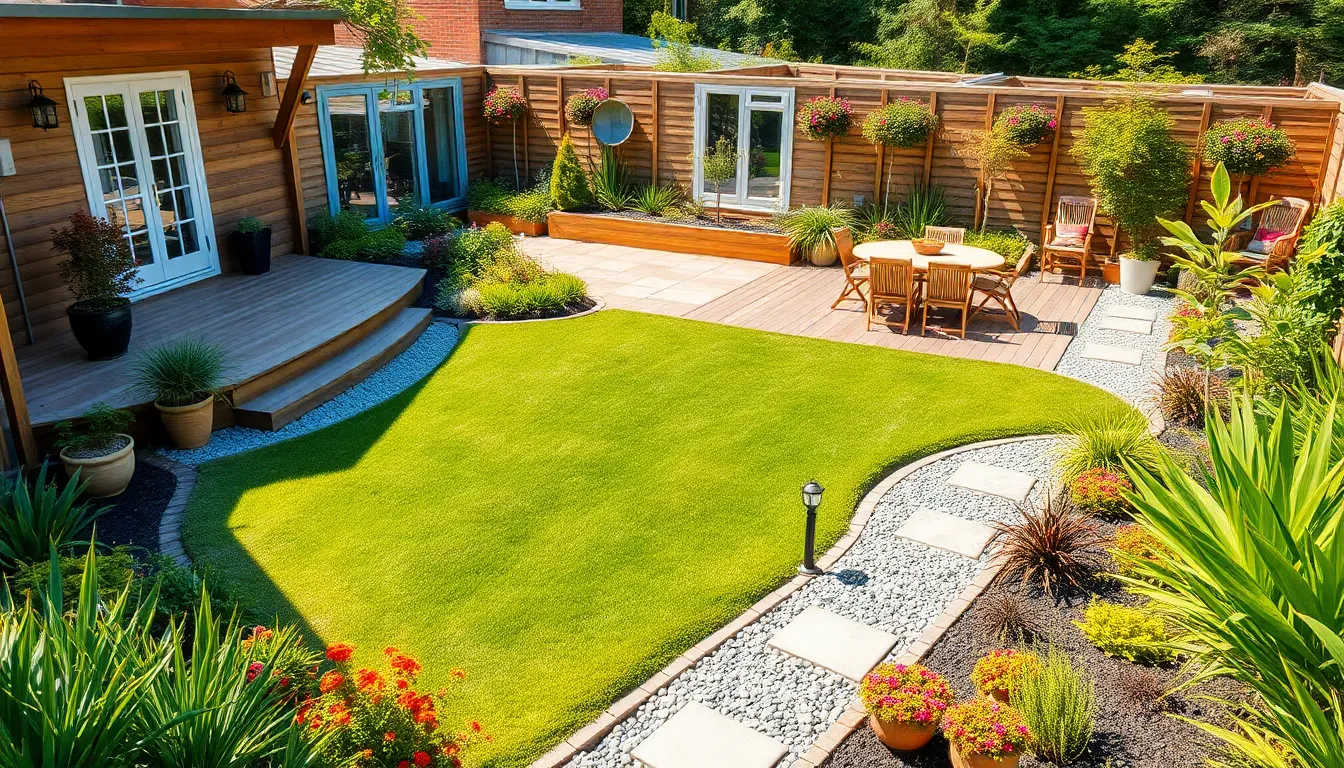
Mixing different ground surfaces creates visual depth and helps define distinct zones within your L-shaped garden layout. We’ll explore three effective combinations that transform your space into a ever-changing outdoor environment.
Combine Decking with Natural Grass
Decking creates an elevated platform perfect for dining or lounge areas, while natural grass provides a lush contrast for relaxation spaces. We recommend installing the deck in your garden’s wider section to accommodate outdoor furniture and entertaining activities.
Natural grass works beautifully in the narrower arm of your L-shaped garden, creating a soft play area or peaceful retreat zone. The contrast between the structured lines of decking and the organic texture of grass adds visual interest throughout your space.
Positioning your deck strategically allows it to serve as a transition point between different garden zones. Grass areas surrounding the decking create a seamless flow that connects various sections of your outdoor sanctuary.
Mix Gravel Paths with Planted Borders
Gravel paths guide visitors through your garden while linking different areas and creating a natural sense of flow between zones. We suggest using light colored gravel to brighten narrow sections and create the illusion of more space.
Planted borders alongside gravel pathways add structure and define the walking routes through your L-shaped layout. Choose plants with varying heights and textures to create visual depth as visitors move from one section to another.
Maintenance becomes simpler with gravel paths since they require less upkeep than traditional lawn areas. The combination allows water to drain naturally while providing a stable walking surface that works in all weather conditions.
Blend Patio Areas with Garden Beds
Patios serve as entertainment hubs while nearby garden beds add greenery and visual interest to your outdoor space. We recommend positioning your main patio in the corner where both arms of the L-shape meet for maximum accessibility.
Garden beds integrated around patio edges soften the hard lines of stone or concrete surfaces. This combination creates natural boundaries between different activity zones without requiring additional fencing or barriers.
Strategic placement of garden beds near patio areas provides privacy screening and helps reduce noise from neighboring properties. Choose fragrant plants and colorful flowers to enhance the sensory experience of your entertainment spaces.
Plan Lighting Solutions for Evening Ambiance
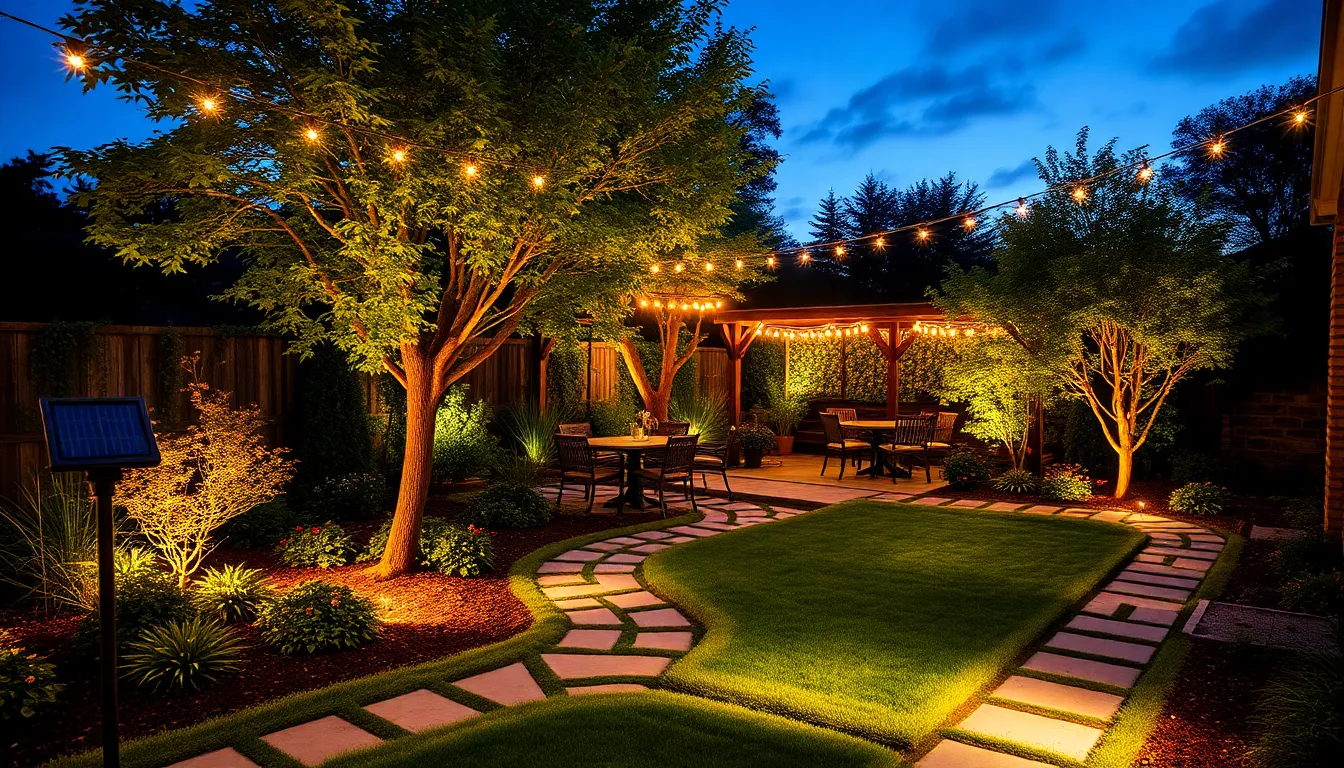
L-shaped garden lighting transforms your outdoor space into a magical evening retreat. Well-planned illumination extends your garden’s usability while creating stunning visual effects that highlight your industry design.
Install Solar Path Lights Along Walkways
Solar path lights provide essential safety illumination without requiring electrical installation or increasing energy costs. These eco-friendly fixtures automatically turn on at dusk and charge during daylight hours, making them perfect for the meandering pathways that connect your L-shaped garden’s two arms.
Position these lights every 6-8 feet along your stone walkways or stepping stone paths to ensure consistent illumination. We recommend choosing fixtures with warm white LEDs that create a welcoming glow without overwhelming the natural ambiance. Modern solar path lights offer 8-12 hours of continuous lighting and work effectively in both the wider dining section and narrower reading nook areas.
Stakes or ground-mounted options work best for grass areas, while post-mounted versions suit gravel paths and wooden boardwalks perfectly. The soft illumination helps visitors navigate between different garden zones safely while maintaining the peaceful atmosphere you’ve created.
Add String Lights Over Entertainment Areas
String lights create instant ambiance and transform your dining and seating areas into cozy outdoor rooms. These versatile lighting answers work exceptionally well over pergolas, between posts, or along fence lines in your L-shaped garden’s entertainment zones.
Install weather-resistant LED string lights with warm white or soft yellow bulbs to create a restaurant-quality atmosphere for evening gatherings. We suggest using 25-50 foot strands with bulbs spaced 12 inches apart for optimal coverage over dining tables and lounge seating areas.
Pergola installations benefit from crisscross patterns that create a ceiling of light, while fence-mounted strings can outline the perimeter of your entertainment space. Solar-powered string light options eliminate the need for outdoor electrical outlets and automatically illuminate your space each evening. The warm glow encourages longer outdoor conversations and makes your garden feel like an extension of your indoor living space.
Place Spotlights on Key Garden Features
Strategic spotlight placement transforms your L-shaped garden’s focal points into dramatic evening displays. These targeted lights highlight statement trees, sculptures, water features, and architectural elements that define your garden’s character after dark.
Install low-voltage LED spotlights at the base of ornamental trees positioned at each arm’s end to create stunning silhouettes against walls or fences. Water features like corner fountains or ponds benefit from underwater or adjacent lighting that creates mesmerizing reflections and movement patterns.
Adjustable spotlights allow you to modify beam angles seasonally as plants grow and change, ensuring year-round visual impact. We recommend using lights with 3000K color temperature for natural-looking illumination that doesn’t alter plant colors dramatically. Timer controls or smart switches let you customize when these accent lights activate, creating different moods throughout the evening hours.
Position ground-mounted fixtures 3-4 feet away from featured plants or sculptures to avoid harsh shadows while providing adequate illumination. This strategic lighting approach draws visitors through your garden’s distinct zones and showcases the unique elements that make your L-shaped space special.
Choose Plants That Work Well in L-Shaped Configurations
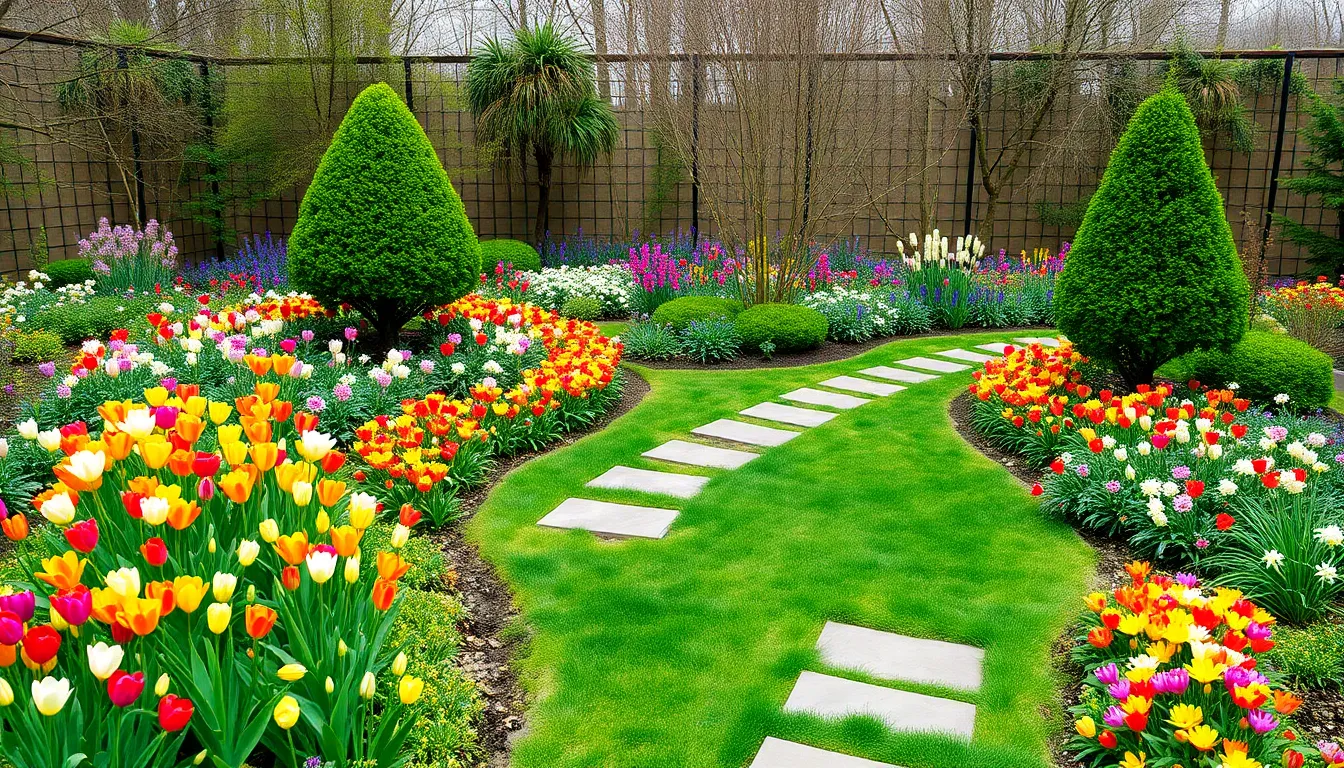
Selecting the right plants for your L-shaped garden requires understanding the diverse conditions these unique spaces offer. Since these gardens often feature varying sun and shade patterns, we can create ever-changing plantings that thrive throughout both arms of our garden.
Select Corner-Friendly Shrubs and Trees
Corner areas in L-shaped gardens need plants that can soften sharp angles while providing year-round structure. Boxwood shrubs work exceptionally well in these spaces, offering dense foliage that maintains its shape with minimal pruning. Holly varieties bring both evergreen appeal and seasonal berries, creating visual interest at the junction points of your garden arms.
Dwarf fruit trees serve double duty in corner spaces, providing both ornamental beauty and practical harvests. Compact apple or pear varieties fit perfectly in these transitional zones without overwhelming the space. These selections help frame the garden’s geometry while adding layers of texture and seasonal change.
Japanese maples offer stunning fall color and delicate branching patterns that complement the angular nature of L-shaped layouts. Their moderate size makes them ideal corner anchors that won’t outgrow their designated spaces.
Plan Seasonal Color Throughout Both Garden Arms
Creating year-round interest in both sections of your L-shaped garden requires strategic seasonal planning. Spring bulbs like tulips and daffodils should be planted in clusters throughout both arms, providing early season color when most plants remain dormant.
Summer flowering perennials such as coneflowers, black-eyed Susans, and bee balm extend blooming periods across warm months. Position these in sunny areas of your garden, typically the south-facing sections that receive consistent light throughout the day.
Autumn foliage plants including burning bush, oakleaf hydrangea, and ornamental grasses create spectacular fall displays. These selections ensure that both garden arms maintain visual appeal as temperatures drop and growing seasons shift.
Winter interest plants like winterberry holly, ornamental cabbage, and evergreen conifers prevent the garden from looking barren during cold months. Strategic placement of these plants maintains structure and color when deciduous varieties go dormant.
Design Sight Lines Between Different Garden Sections
Creating visual connections between your garden’s two arms transforms separate spaces into one cohesive design. Meandering stepping stone paths link different areas while encouraging leisurely exploration of the entire garden space.
Diagonal pathways cut across the corner junction, creating movement and drawing the eye from one section to another. These paths work particularly well when bordered with low-growing plants that won’t obstruct views.
Focal point plantings at the ends of each garden arm serve as natural destinations that encourage movement throughout the space. Ornamental trees like flowering dogwood or redbud create stunning endpoints that draw visitors through the entire garden.
Statement planters positioned at key visual points help establish rhythm and repetition throughout both garden sections. Large containers with seasonal plantings can be moved and rearranged to maintain fresh perspectives and seasonal interest.
Sculpture or garden art placed strategically creates visual anchors that connect distant areas of the garden. These elements work best when they complement rather than compete with your plant selections.
Consider Practical Storage and Utility Solutions
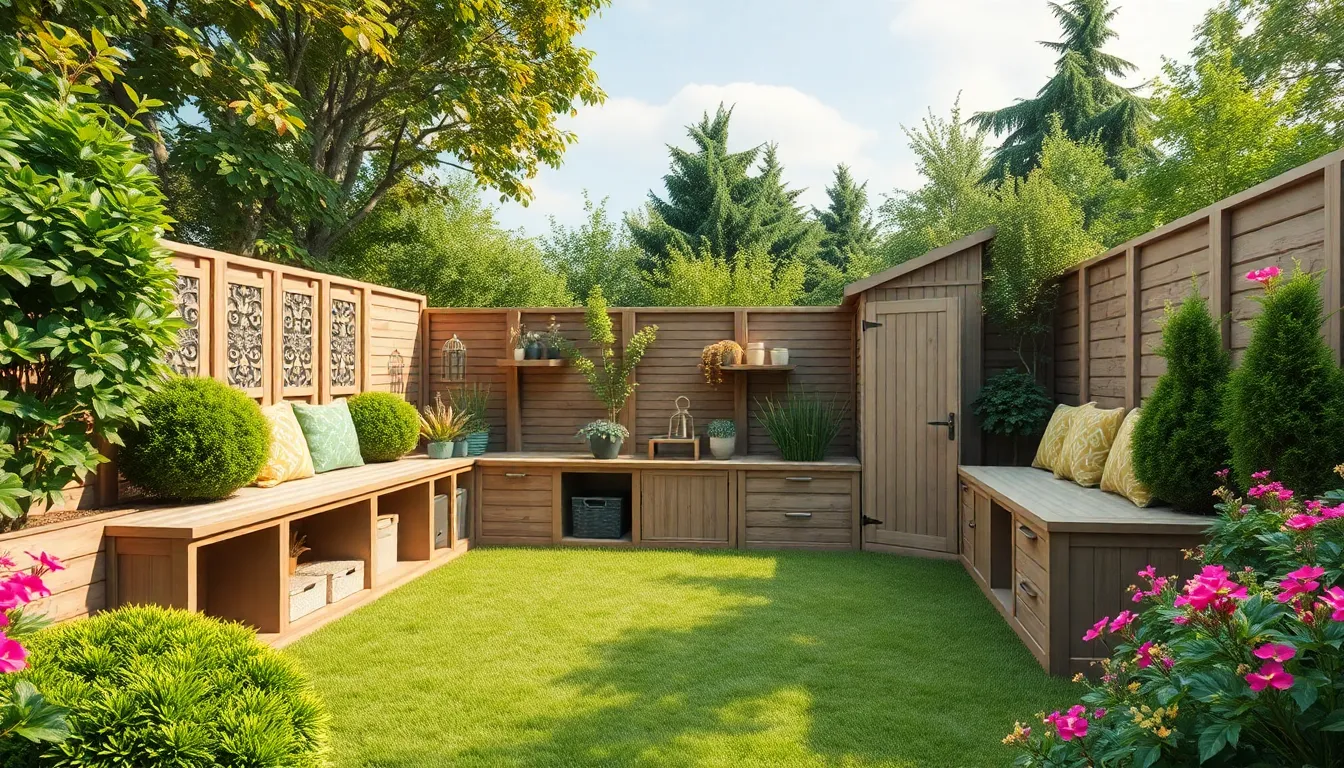
Effective storage transforms your L-shaped garden into a more organized and visually appealing space. Smart utility answers help maintain the garden’s beauty while keeping essential items accessible yet hidden from view.
Hide Bins and Equipment in the Garden’s Corner
Corner spaces in L-shaped gardens provide perfect hiding spots for unsightly bins and equipment. We recommend installing compact storage units that fit snugly into these angular spaces without disrupting the garden’s flow. Decorative screens made from bamboo or cedar can effectively disguise waste bins while allowing easy access for collection days.
Strategically placed foliage offers another excellent camouflage option for storing garden equipment. Dense shrubs like boxwood or holly create natural barriers that conceal storage areas while adding year-round structure to your garden. Consider positioning these plantings to form a living wall that blocks the view of bins from main seating areas.
Install Built-In Seating with Storage
Built-in seating with hidden storage compartments maximizes functionality in both arms of your L-shaped garden. These clever installations provide comfortable spots to relax while concealing gardening tools, cushions, and outdoor accessories beneath the seats. Weather-resistant materials like composite decking or treated cedar ensure your storage seating withstands seasonal changes.
Positioning these storage benches along the garden’s perimeter creates defined borders while maintaining clean sight lines throughout the space. We suggest incorporating hinged tops with soft-close mechanisms to prevent slamming and protect stored items from moisture. Cushions and throw pillows can transform these practical pieces into inviting outdoor furniture that enhances your garden’s comfort level.
Create Screened Areas for Garden Tools
Dedicated screened areas keep garden tools organized and protected from weather elements throughout the seasons. Small storage sheds positioned in less visible sections of your L-shaped garden provide comprehensive protection for larger equipment like lawnmowers and hedge trimmers. Lattice panels or wooden screens create attractive boundaries around these utility zones without completely blocking natural light.
Covered storage sections integrated into existing garden structures offer space-efficient answers for tool organization. Wall-mounted tool racks behind decorative screens keep frequently used items like pruning shears and hand trowels easily accessible yet neatly arranged. These screened storage areas prevent tools from cluttering your outdoor living spaces while extending their lifespan through proper protection.
Conclusion
We’ve explored many ways to transform your L-shaped garden from a challenging space into a stunning outdoor sanctuary. By creating distinct zones dividing your garden into functional areas and incorporating vertical elements you can maximize every corner of your unique layout.
The key lies in understanding how to work with your garden’s natural configuration rather than against it. Strategic pathways connect both arms seamlessly while thoughtful plant selection and lighting answers extend your garden’s beauty throughout the seasons.
Remember that successful L-shaped garden design comes down to balancing functionality with visual appeal. Whether you’re installing water features in corner spaces or creating storage answers that blend seamlessly into your industry these ideas will help you unlock your garden’s full potential and create an outdoor space you’ll love spending time in.
Frequently Asked Questions
What makes L-shaped gardens challenging to design?
L-shaped gardens present unique challenges due to their angular configuration and the need to connect two distinct arms seamlessly. The corner junction can create awkward spaces, and varying sun exposure patterns across different sections require careful plant selection. However, these challenges also create opportunities for distinct zoning and creative design solutions.
How can I create distinct zones in my L-shaped garden?
You can create three main zones: a formal dining area in the wider section with outdoor lighting and wind barriers, a quiet reading nook in the narrower arm with comfortable seating and privacy landscaping, and a safe children’s play area in the most visible section using soft materials and engaging plants.
What are the best ways to maximize corner spaces in L-shaped gardens?
Install corner water features like small fountains or ponds to create visual interest and attract wildlife. Build curved border gardens with varying plant heights to soften angular layouts. Place statement trees at the ends of each arm as focal points that encourage exploration and provide structural framework.
How should I design pathways to connect both arms of the garden?
Create meandering stone pathways using natural materials like flagstone or slate to soften sharp angles. For budget-friendly options, use stepping stones through grassy areas. Consider wooden boardwalks for narrow or wet sections, providing a rustic way to link different areas while ensuring durability.
What vertical elements work best in L-shaped gardens?
Construct pergolas over seating areas to create intimate outdoor rooms and natural shade while supporting climbing vines. Use trellises to maximize vertical growing space and create living privacy screens. Install privacy screens to define distinct areas using materials that allow light circulation while adding greenery.
How can I use different ground surfaces effectively?
Combine decking with natural grass by positioning decks in wider sections for dining areas and using grass in narrower arms for play spaces. Mix gravel paths with planted borders to guide visitors naturally. Blend patio areas with garden beds to soften hard lines and enhance privacy.
What lighting solutions work best for L-shaped gardens?
Install solar path lights along walkways for safety and warm ambiance using warm white LEDs. Add string lights in entertainment areas for cozy atmosphere. Use spotlights strategically to highlight key features like statement trees and water elements, extending garden usability into evening hours.
Which plants are best suited for L-shaped gardens?
Choose corner-friendly shrubs like boxwood and holly to soften sharp angles and provide year-round structure. Select dwarf fruit trees and Japanese maples for ornamental beauty. Plan seasonal color with spring bulbs, summer perennials, autumn foliage plants, and winter interest varieties to maintain appeal year-round.
How can I create better sight lines between garden sections?
Design meandering paths and diagonal pathways to encourage movement between sections. Use focal point plantings and statement planters to draw the eye through the space. Place garden art strategically to enhance visual connections and create a cohesive flow throughout both arms.
What storage solutions work well in L-shaped gardens?
Utilize corner spaces for compact storage units hidden behind decorative screens or dense foliage. Install built-in seating with hidden storage compartments to maximize functionality. Create dedicated screened areas for garden tools to maintain organization while keeping essential items accessible yet discreetly stored.




